After a couple of years of using a portable table saw, which actually belongs to my older brother (thanks, Steve!), I decided to purchase an upgraded table saw for my woodworking projects. I’ll describe a bit of why I decided on this model and what I think of it in this post.
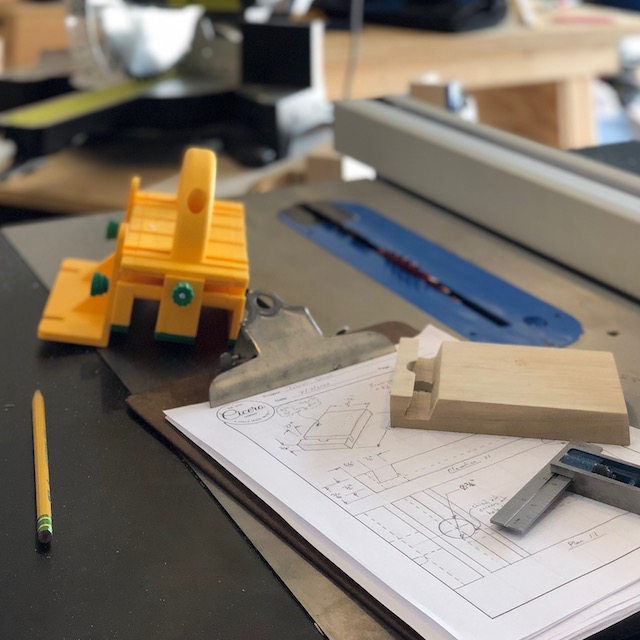
The Old Saw
First, about the old table saw. It’s a Ryobi and it really did serve me well on quite a few projects. I certainly pushed the limit of what this saw is capable of. And for probably 90% of the projects, it was up to the task. Seriously, for a lot of DIY’ers, this is a perfectly good saw. I put a quality blade (a 50 tooth Freud Diablo), which dramatically improves the cut of any saw. I built a cross-cut sled that made a lot of cuts feasible.
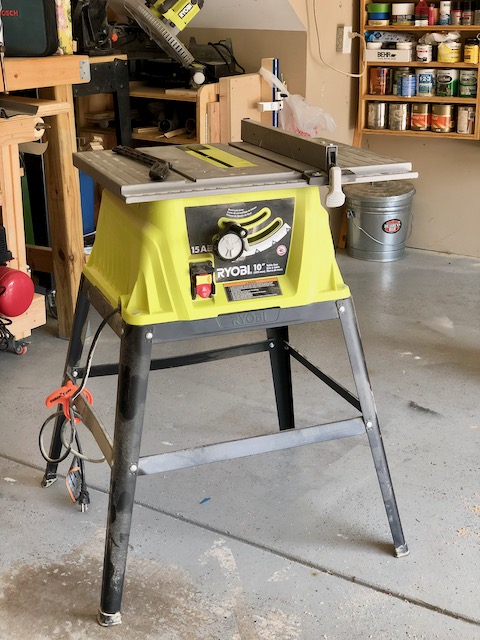
But the saw is very lightweight, and sometimes pushing the sled into the blade would actually start to tip the entire saw! Also, the fence while actually pretty accurate, isn’t great. So, if you’re just ripping medium size pieces or making small cross-cuts, this saw can manage it. I actually even managed to rip down bed rails from a full size 4’x8’ sheet of 3/4″ maple plywood on this little thing! One place where this kind of saw just completely fails, though, is in dust collection. That is, there is none other than gravity generally making a giant pile beneath the saw.
New Saws Out There
I did quite a lot of research on table saws. I did consider a “job site” saw and putting it on a mobile base (or even re-building my mobile workbench). These are some pretty great saws in the $250-$600 price range. The next jump up in price range is a “hybrid” table saw, which is nominally portable (if “portable” only means having casters and weighing under 250 lbs). These have the larger table of a cabinet saw and typically better fence systems. These tend to be in the $700-$1,200 price range. Of course, there are cabinet saws for professionals which cost far more, typically require 220v power, and are far more saw than I could ever justify. And there are Saw Stop saws in all these categories and while their flesh-sensing system is amazing, I also can’t justify the cost for those. Really, Saw Stop sort of sit in a class of their own, in my opinion.
Within the hybrid saw class, most of the saws are really around $1,000 and up. There are some great saws in that price range. The big box stores have a couple of “entry” level models, though: the Ridgid and a Delta (why Lowes hasn’t label-slapped this as a Kobalt, I don’t really know). Between the two of those, the Delta seemed to typically get better reviews and was a bit cheaper at $600 at the time I purchased it (July 2020). Further, the Delta just got a newer version released with some decent improvements. Home Depot actually does also carry the Delta, but at $300 more.

The Delta 36–725T2
So what kind of table saw do you get for $600? First of all, a Biesemeyer fence system, which can cost over $400 separately. The center of the table is cast iron and the wings are steel. I found that the top may have a slight dip to the middle (that is, I could see a slight bit of light beneath a straight edge laid across it), but is more than flat enough for anything I’ll ever want to make. The wings aren’t stamped sheet metal, but actually steel plate, similar in thickness to the angle rails and square tube used for the front fence. Even the blade that is included is pretty decent. I ripped two 4′ lengths of 3/4″ plywood to make some French cleats and it was a clean cut on both. And while the dust collection isn’t perfect, it’s actually quite good. Also, the mitre included has a nice steel bar and heavy plastic body.
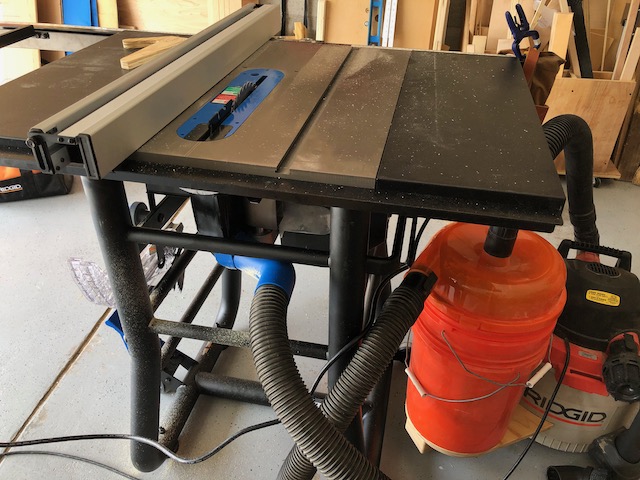
The entire saw took me about 2–1/2 hours to assemble, and that includes having to take apart almost the entire thing to swap the side the swivel caster was on. Also, I should have paid closer attention to the hole patterns on the wings, as I had to turn those around and re-level them. If I’d paid closer attention, I could have easily been done in under two hours without rushing. My wife did need to help me get the box out of the back of our SUV by lowering one end down to the floor. Otherwise, I was able to put the saw together by myself, including tipping it up (I used an extra scrap 2x to help tip it easy so I could get my hands under the cast iron top and just squat lift).
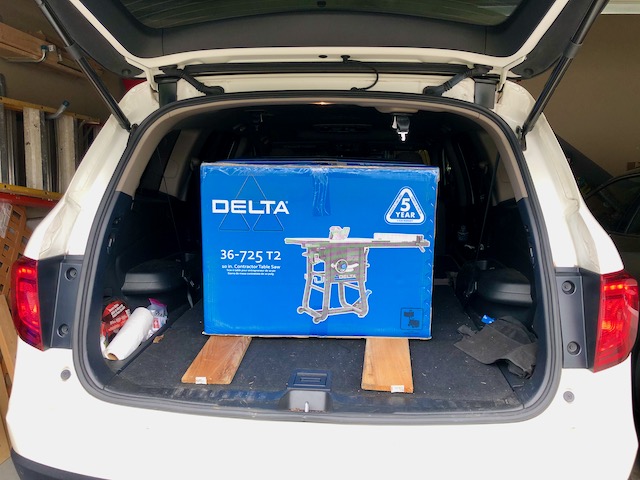
The box slid into the back of my Pilot 
Table saw packaging is very good 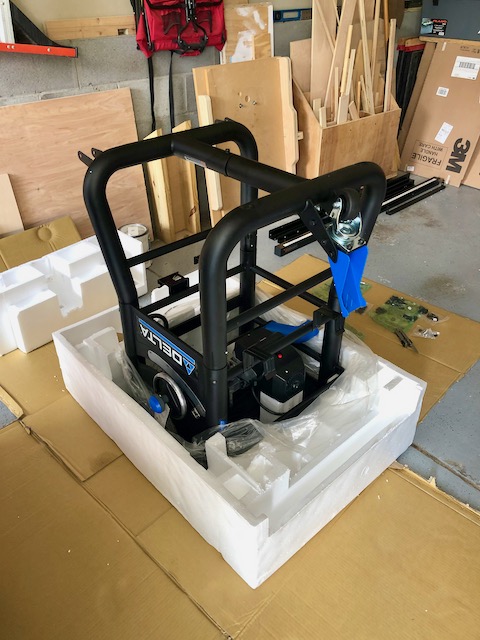
Assembly the tube steel frame 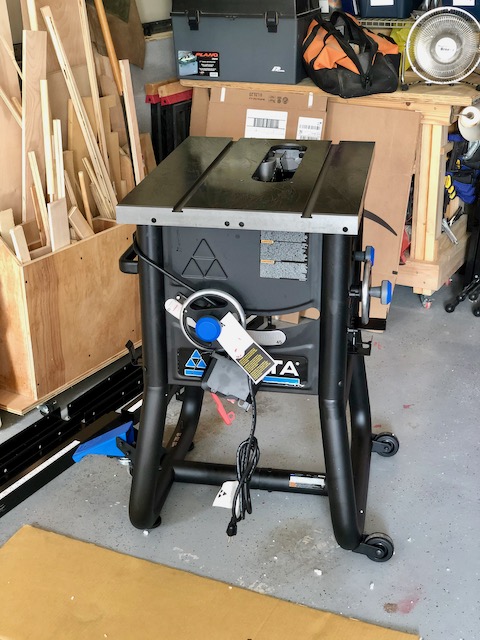
Turned up-right 
Rails on 
Using square fence tube to align wings
The assembly process was pretty easy. Delta even has a step-by-step video on YouTube.

The scale on the rail was nearly spot-on out of the box. Similarly, the saw was very close to parallel to the mitre slots. How close? Well, I couldn’t actually measure the difference with a quality sliding square, but I could hear a tooth rubbing the end more at one end than the other. So yeah, pretty close. The fence is pretty spot on and super easy to adjust. I saw a few reviewers commenting that the angle gauge was off, but mine was within 1–2 tenths of a degree. It’s also easy to adjust (and, honestly, I have a digital angle gauge so I’m more likely to rely on that anyway). I haven’t run into anything about the saw so far that I couldn’t quickly tweak.

The saw is a bit bigger than I’d hoped, though (hold on, I’ll explain). I had planned on just rolling it beneath my fixed work bench. Since I couldn’t, I ended up having to re-arrange a lot in my garage. This was my biggest worry, but it ended up just fine and frankly, having to clean up the garage wasn’t the worst thing in the world. Fortunately, the casters are pretty good and the saw rolls & turns very easily despite weighing 220 lbs. I’ve moved it in and out of the “parked” spot several times for use now and it’s not been a bother.
Using the Saw
So I’ve used the saw for several different cuts now. As I mentioned earlier, I did several long-ish rips of plywood to make some French cleats. I also ended up having to cut down sides and back panels of an IKEA wall vanity (pine and hardboard). I used the mitre gage to make the cross cuts on the side panels as I haven’t made a new sled for this table saw yet. However, the mitre gage worked great for this purpose. I cut about half-way through the side piece, flipped it over and repeated. This reduced tear-out on both faces (and by reduced, I mean there was zero). But of course, to do this you have to have the blade dead parallel to the mitre gage and it was (again, right out of the box!).
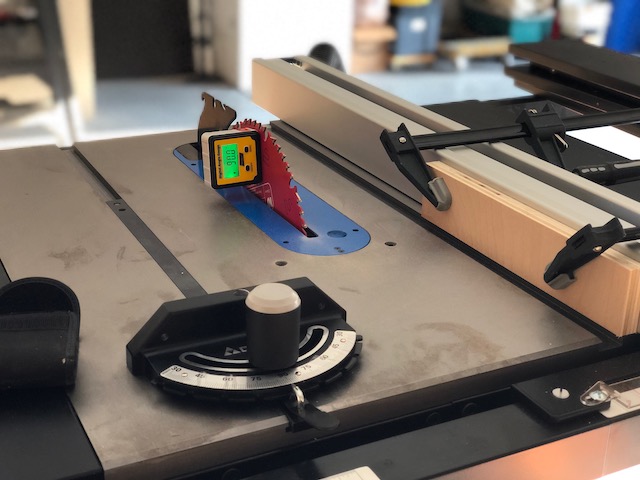
The fence has a small rail that folds out on the right-hand side to make cuts on thin stock, such as the hard board back panels. This works perfect and prevents the material from sliding under the fence (which sits about 1/8″ above the table top). I also used the table saw to cut an angled dado into a poplar board, which was used to make a tablet/phone stand. I also used the saw to cut down some 1/4″ underlayment boards for a tiling project. So, not a ton of use, but a pretty good variety of types of cuts and everyone has had me even more happy with the purchase.
I do wish I’d cleaned and waxed the cast iron top as soon as I got it put together, though. It took only about 2–3 days for the Tennessee summer humidity to charm some rust out of the cast iron. I’ve since sanded, cleaned, and waxed it, but now there are some stains in the cast iron. They don’t in any way affect the saw, but good tools are worth taking good care of.
Lastly, one feature I didn’t know that I’d like so much is just how quiet this saw is. The magnetic start button is great and the saw is so much quieter than my shop vac, I can barely hear it!
Misc
A couple of things I had been curios about before getting it, so I’ll answer those here just in case anyone else is interested:
- The box is 30″ x 24″ x 19″ and includes everything, including the rails (I think the larger top version has a separate box).
- A Lowes employee helped me load the box onto a flat cart and a couple of others loaded it into my vehicle for me, but my wife and I were able to slide it out and down out of the back of the SUV. Beats paying a $60–70 delivery fee!
- The length of the rear rail is 54 3/8″ and the distance from the spreader bar to the end of rear rail is 2 1/2″. The front rail is 62″. I think I was able to look up all the other dimensions online.
- The tubular frame is crazy strong (like, I’m a structural engineer and I’ve seen buildings with smaller tube members); though it is rectangular. That is to say, you can rotate the lower half so the swivel lift caster is on the left or right, but not the front or back.
- The three caster wheel occasionally “tips” a bit, but the corner of the frame prevents it from tipping more than just a few inches. So, the saw isn’t going to fall over on you; just occasionally catch if you make some aggressive maneuvers while moving it.